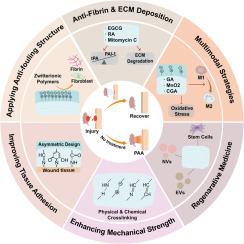Postoperative abdominal adhesions: pathogenesis and advances in hydrogel-based multimodal prevention strategies
IF 9.6
1区 医学
Q1 ENGINEERING, BIOMEDICAL
引用次数: 0
Abstract
Postoperative abdominal adhesions (PAA) occur frequently (> 90%) after abdominal surgery and commonly lead to various serious postoperative complications. Adhesiolysis remains the sole effective clinical method to release adhesions; however, recurrence rates are as high as 80%. Current clinical strategies for preventing PAA primarily rely on applying anti-adhesion barriers. However, the limited functionality of physical barriers results in suboptimal clinical outcomes. Among biomaterials, hydrogels are considered one of the most promising physical barriers due to their satisfactory wound coverage and tunable mechanical properties. Therefore, this review aims to provide guidance for the rational design of multifunctional anti-adhesion hydrogels by combining the pathophysiological mechanisms of PAA. A systematic review of the latest reviews and original research articles searched from PubMed and Web of Science databases was performed. We first introduce the structure of the peritoneum and the normal healing process after peritoneal injury. Next, we analyze the key events and immune cell behaviors in the development of PAA and elucidate the main influencing factors. Based on the interplay between the pathogenesis of PAA and current clinical practice, we propose six hydrogel-based adhesion prevention strategies. These hydrogels can be fabricated by physical cross-linking, chemical cross-linking, physical/chemical cross-linking, self-assembly or 3D printing, and applied to the wound surface by pre-preparation or in situ cross-linking. Finally, the relevant applications of each strategy are summarized and their future potential is discussed.
Statement of significance
Postoperative abdominal adhesions (PAA) affect >90% of patients undergoing abdominal operations and cause serious complications. Compared to conventional liquid or film-based physical barriers, hydrogels have various advantages and become a promising alternative that attracted widespread attention from researchers. This review aims to provide guidance for the rational design of multifunctional anti-adhesion hydrogels by aligning with the pathophysiological mechanisms of PAA. First, the mechanisms driving PAA formation are outlined, with particular attention to critical pathological steps and immune cells contributions. Next, several hydrogel optimization strategies developed in latest years aligned with mechanistic insights and clinical demands are systematically summarized. For each strategy, recent advances and limitations are critically analyzed. Finally, existing limitations and future research priorities are discussed to guide next-generation barrier development.

术后腹部粘连:基于水凝胶的多模式预防策略的发病机制和进展。
术后腹腔粘连(PAA)是腹部手术后常见的并发症,发生率高达90%。粘连松解仍然是临床释放粘连的唯一有效方法;然而,复发率高达80%。目前预防PAA的临床策略主要依赖于应用抗粘连屏障。然而,物理屏障的有限功能导致临床结果不理想。在生物材料中,水凝胶被认为是最有前途的物理屏障之一,因为它们具有令人满意的伤口覆盖和可调的机械性能。因此,本文旨在结合PAA的病理生理机制,为多功能抗黏附水凝胶的合理设计提供指导。对从PubMed和Web of Science数据库中检索到的最新评论和原创研究文章进行了系统的综述。我们首先介绍腹膜的结构和腹膜损伤后的正常愈合过程。接下来,我们分析了PAA发生的关键事件和免疫细胞行为,并阐明了主要影响因素。基于PAA发病机制与临床实践的相互作用,我们提出了六种基于水凝胶的粘连预防策略。这些水凝胶可以通过物理交联、化学交联、物理/化学交联、自组装或3D打印制备,并通过预制备或原位交联应用于伤口表面。最后,总结了每种策略的相关应用,并讨论了它们的未来潜力。意义声明:术后腹腔粘连(PAA)影响90%的腹部手术患者,并导致严重的并发症。与传统的液体或膜基物理屏障相比,水凝胶具有多种优点,成为一种很有前途的替代品,受到了研究者的广泛关注。本文旨在结合PAA的病理生理机制,为多功能抗黏附水凝胶的合理设计提供指导。首先,概述了驱动PAA形成的机制,特别关注关键的病理步骤和免疫细胞的作用。接下来,系统总结了近年来根据机理见解和临床需求开发的几种水凝胶优化策略。对于每种策略,都批判性地分析了最近的进展和局限性。最后,讨论了现有的局限性和未来的研究重点,以指导下一代屏障的开发。
本文章由计算机程序翻译,如有差异,请以英文原文为准。
求助全文
约1分钟内获得全文
求助全文
来源期刊

Acta Biomaterialia
工程技术-材料科学:生物材料
CiteScore
16.80
自引率
3.10%
发文量
776
审稿时长
30 days
期刊介绍:
Acta Biomaterialia is a monthly peer-reviewed scientific journal published by Elsevier. The journal was established in January 2005. The editor-in-chief is W.R. Wagner (University of Pittsburgh). The journal covers research in biomaterials science, including the interrelationship of biomaterial structure and function from macroscale to nanoscale. Topical coverage includes biomedical and biocompatible materials.
 求助内容:
求助内容: 应助结果提醒方式:
应助结果提醒方式:


